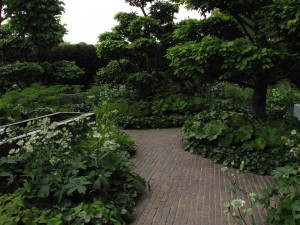Garden Design Trends For 2016
Part 1. The trend is in the detail
Hear the word trend and it starts to sound expensive – right? But, to be on trend doesn’t mean you have to take out a loan to achieve it. It’s all in the small details.
However, whilst some garden trends are keepers, thankfully others aren’t adverse to change (remember bell bottoms?) I rest my case.
Ok, for an example: over the past few years the garden designers at Landspace have noticed a strong trend for the buzzword ‘sustainable’. Clients have been genuinely interested in using sustainable products and there has been a defining increase in the trend to design gardens that are sustainable, ethical and that will attract wildlife into their outdoor spaces. Clients are choosing trees and plants that support the local wildlife and for those that have children – areas of the garden to educate them about the natural world. Keen for their little ones to have hands on experience there has been a notable increase for the request for raised beds for growing home produced fruit and vegetables. This in our opinion is a keeper.
Trends that we would happily see the back of are masses of amenity style concrete paving and being asked for no maintenance planting. This we place in the – not adverse to change category.
So, what other trends do the designers at Landspace predict for 2016?
Continuing the sustainable theme, the collective feedback from the design department is Kebony. Although there is a general trend away from decking, when it is a ‘must have’ for the design, Kebony is our wood of choice. Why are we championing this wood? Well, that’s easy to answer. Developed in Norway, Kebony is a softwood that has been treated to behave like a hardwood. The process is completely eco-friendly and the wood has been given the Nordic Swan Eco-label by the Nordic council of ministers. The transformation process of turning softwood into hardwood is completely non-toxic and the resulting Kebony is not toxic to humans. It is not known to splinter like hardwoods and is often selected for use as Kindergarten decking. The wood starts off with a deep brown colour that turns to an attractive silver-grey patina over time.
All the wood is sourced from sustainably managed forests and carries the FSC® certification. Saving the hardwood forests of the world from unsustainable logging is a ‘no brainer’.
Other trends predicted include; monochromatic colour planting schemes, painted fences and boundaries and the use of traditional clay pavers to replace concrete and stone.
Why the landscape designers at Landspace are championing clay pavers.
Clay pavers have been creeping into the Chelsea flower show for many years. Tom Stuart-Smith and Cleve West both created award winning gardens using clay pavers. But it is only in recent years that this resurgence has found its way into the domestic garden.
Clay pavers look (in our opinion) both stylish and aesthetically pleasing to the eye. As a product they are very versatile and look equally at home in a stylized ‘contemporary’ garden as they do in an informal cottage ‘arts and crafts’ style garden.
The use of clay pavers is far more environmentally friendly than vast areas of paving slabs. It is also relatively easy to establish shallow rooting, creeping plants to grow in between the laid pavers. In a sunny aspect try growing plants such as: Thymus serpyllum, Thymus pseudolanuginosus or Thymus ‘Doone Valley’. You could also try growing alpine strawberries, (Fragaria vesca).


